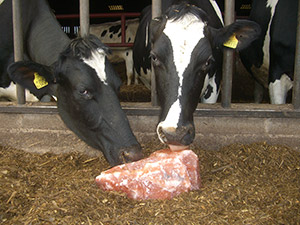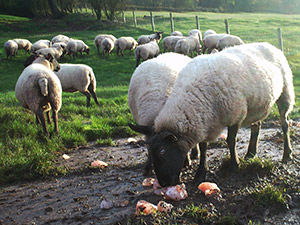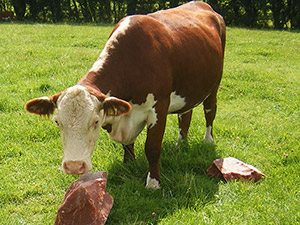
A 550 million year old source of minerals and trace elements for your livestock/horses. Mined from the vast and ancient Himalayan mountains, these salt licks must be the purest form of salt available. The distinctive rose pink colour comes from the salts mineral content, such as iron, potassium and magnesium, which are all vital for maintaining health. Mass produced salt licks are produced using salt with minerals added in the manufacturing process. Himalayan rock salt licks are literally 'rock hard’, this means that livestock and horses are unable to bite chunks off the block, a problem that can occur with the softer ’pressed’ salt licks. These licks are also much more weather resistant and will not dissolve into a mush when left out in the rain, which means they can be safely left outside in the field for horses or cows to ‘self dose’. Our experience has shown that horses and cows do prefer these to other salt licks.
Cows/sheep/goats and horses all have a very well defined appetite for sodium chloride (SALT) only surpassed by the need for water. Because the majority of plants do not provide sufficient sodium for the livestock/horses needs and may lack adequate chloride, salt supplementation is a vital part of any animal’s nutritional requirement.

Trace minerals are now universally recognised as being essential in the livestock/horses diet. There are seven trace elements that have shown to be needed to be supplemented. These elements are Copper, Cobalt, Zinc, Iodine, Iron, Manganese and selenium. These additives are only required in very small amounts, measured in parts per million, thus the name “trace minerals or trace elements.”
Deficiencies in trace minerals do in fact occur more frequently than is usually recognised by the majority of livestock/horse owners. This sub-clinical deficiency is far more wide spread than acute deficiencies. Sub-clinical deficiency can lead to under performance by the livestock/horse, for example, reduced growth rates, loss of feed efficiency and a depressed immune system. This can then result in inefficient performance. There is, therefore, an important role for mineral and trace element supplementation to help to maximise equine health.

Along with the hidden performance losses discussed, animals short of salt and essential elements can show ‘pica’ or depraved appetite symptoms. These deficiency indicators can include licking wood and stones, eating soil or bark. Horses constantly searching the hedge rows in good grass pasture can often be telling the owners that there is a mineral deficiency in its diet.
There is increasing evidence to show that many minerals and trace mineral nutrients are needed at higher levels to improve the livestock/horses immune system to enable them to cope with infections. Sodium, chloride, zinc, copper, selenium, and magnesium have already been shown to be helpful in this regard. Because salt is self-limiting, it’s inclusion in compound feeds means that horses, already well supplemented, will take less of the free choice salt, while other livestock/horses on a more basic ration will take more salt and so receive the essential minerals and trace elements for their daily needs.